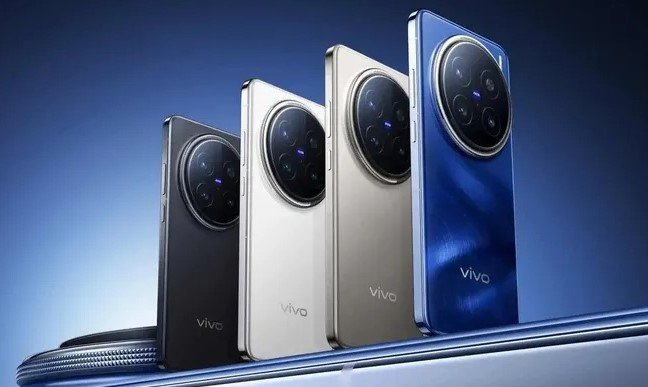Vivo, a leading Chinese smartphone maker, unveiled its new X300 series on October 14, 2025, in Shanghai. The lineup, which includes the standard X300 and the Pro model, focuses on advanced imaging with a 200MP Zeiss camera system and the powerful MediaTek Dimensity 9500 chipset, marking a big step in mobile tech amid growing competition.
Event Highlights and Brand Milestone
The launch event in Shanghai drew attention from tech fans worldwide. Vivo timed the release to celebrate its 30th anniversary, showcasing how far the brand has come in smartphone innovation.
Company leaders highlighted the partnership with Zeiss for camera tech and Sony for sensor development. This move aims to set new standards in photography for everyday users and pros alike.
The event also featured live demos of the phones’ features, including real-time photo editing and video recording. Attendees got hands-on time, praising the sleek design and smooth performance.
Cutting-Edge Camera Technology
The X300 series stands out with its Zeiss-tuned 200MP imaging system. The Pro model boasts a world-first 200MP APO super-telephoto lens with 4X lossless optical zoom, perfect for capturing distant subjects clearly.

Both models include advanced stabilization. The Pro offers CIPA 5.5-level gimbal stabilization, while the standard has CIPA 4.5-level, making them great for shaky hands or fast action like sports events.
Users can enjoy features like “one photo, multiple crops,” which lets you create different shots from a single image. The system also supports AI-powered short videos from photos, adding fun to sharing moments.
A key upgrade is the 85mm telephoto lens on the Pro, with a large 1/1.4-inch sensor and f/2.67 aperture. This setup handles low-light scenes well and records 4K 120fps Dolby Vision HDR video.
The front camera on both is a 50MP unit, ensuring sharp selfies and video calls. Overall, these cameras aim to rival top brands in quality and versatility.
Powerful Performance and Software
At the heart of the X300 series is the MediaTek Dimensity 9500 chipset. This 3nm processor delivers high speeds, with the Pro model scoring over 4.1 million on AnTuTu benchmarks at room temperature.
Vivo paired it with their in-house V3+ imaging chip for better photo processing. This dual-chip setup boosts efficiency in tasks like focus tracking and video editing.
The phones run on OriginOS 6, based on Android 16, bringing fresh features like improved connectivity with Apple devices for calls, messages, and location sharing.
Battery life impresses with 6040mAh on the standard and 6510mAh on the Pro. They support 90W wired charging and 40W wireless, keeping you powered through busy days.
Displays are bright and eye-friendly, with 1.5K LTPO OLED panels at 120Hz refresh rates. They offer 2160Hz PWM dimming and a low 1 nit minimum brightness for comfortable viewing.
Design and Build Quality
Vivo designed the X300 series for durability and style. The standard model is ultra-thin at 7.95mm, while both have IP68/69 ratings for water and dust resistance.
Available in various colors, the phones feature premium materials like scratch-resistant glass. This build ensures they withstand daily use without sacrificing looks.
The lineup includes options for up to 16GB RAM and 1024GB storage, catering to heavy users who need space for apps, photos, and videos.
Pricing and Market Impact
Pricing starts at RMB 4,399 (about $620) for the X300 with 12GB RAM and 256GB storage. The X300 Pro begins at RMB 5,299 (around $745) for the same config, with higher variants available.
In China, these prices position the series in the competitive mid-to-high range. Global rollout is expected soon, including markets like India.
Here’s a quick look at the models:
| Model | Starting Price (RMB) | Key Storage Options | Battery Capacity |
|---|---|---|---|
| Vivo X300 | 4,399 | 12GB+256GB, up to 16GB+1TB | 6,040mAh |
| Vivo X300 Pro | 5,299 | 12GB+256GB, up to 16GB+1TB | 6,510mAh |
This launch comes as China’s smartphone market grows. Shipments hit 140.6 million units in the first half of 2025, with domestic brands like Vivo gaining ground over rivals like Apple, whose shipments dropped 27% year-over-year.
Broader Industry Trends
The X300 series reflects trends toward better cameras and AI integration in phones. With rivals like Huawei and Xiaomi pushing similar tech, Vivo aims to capture more market share in the $562 to $842 price segment.
Experts note that features like cross-device syncing with iPhones could appeal to users in mixed ecosystems. This innovation might influence future Android-iOS interactions.
In recent events, MediaTek’s Dimensity chips have powered several flagships, showing a shift from Qualcomm in some regions. Vivo’s choice here strengthens that trend.
As 5G and AI advance, phones like these make high-end tech accessible. Consumers benefit from better tools for content creation without needing pro gear.
What do you think of the X300 series? Share your thoughts in the comments and spread the word if this excites you.
